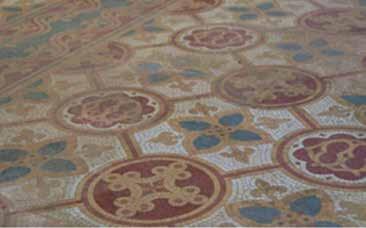
3 minute read
Shrewsbury Cathedral – The Restoration Proceeds by Simon Caldwell
from Oremus April 2020
What’s Under the Carpet?
Simon Caldwell
That blue carpet has to go!
© Zik2
Restoration work at Shrewsbury Cathedral has uncovered beautiful tiles dating from the late Victorian period and turn of the 20th-century. They had been hidden by carpets and an artificial floor following the reordering of the building's interior in more recent times. The concealed floor appears to consist of a mixture of highly-decorative mosaic and encaustic or ‘inlaid’ tiles and were uncovered by workmen of M Salt Ltd, a conservation specialist firm, when a project to recover the original beauty of the Cathedral was initiated at the beginning of March.
Most of the tiles are in a very good condition but there is some damage to the flooring in places where piping was elevated, where concrete was used to fill spaces, and boxes of cables for electric lights were laid. The Rt Rev Mark Davies, Bishop of Shrewsbury, said: ‘It is always an amazing moment to see something that has been hidden from sight for generations suddenly uncovered. I found it particularly moving to find the floor of our Cathedral so well-preserved, giving testimony in all of its intricacy and beauty to the faith and sacrifices of generations before us. We look forward to being able to share this beauty with all who come to the Cathedral’. Richard Keddie, the Development Officer, noted that: ‘The project is about rediscovering beauty. The reordering has been spearheaded by a dedicated team here at the Cathedral, which, under the guidance of Bishop Mark, has worked with various heritage and Church bodies to deliver a sustainable and future-proofing project. Being a once in a lifetime opportunity, the Cathedral, a place of immense historical and religious importance, will certainly add value to our local and regional communities as well as offering enhanced pastoral outreach’.
The tiled floor will be cleaned in time for the liturgies of Holy Week when the Cathedral hopes to be reopened in its entirety to the public. In the meantime, the tiles and other parts of the restorations can be seen by the public from the viewing gallery on Saturdays from 12 noon and Sundays from 8.30am. In the months ahead, the Cathedral will seek the guidance and advice of the Historic Churches Committee of the Bishops' Conference of England and Wales and of the Diocesan Heritage, Art, and Architecture Committee about proposals for the renewal of the sanctuary, hoping wherever possible to be inspired by the original design.
The Cathedral Church of Our Lady Help of Christians and St Peter of Alcantara was begun in 1853 and opened by Cardinal Nicholas Wiseman in 1856. The original design was drawn up by Augustus Welby Pugin at the request of John Talbot, 16th Earl of Shrewsbury. Both the Earl and Pugin died in 1852 before the Cathedral was off the drawing board, but the Earl's 20 year-old-heir, Bertram, was happy to continue the project and turned to Pugin's eldest son, Edward, to complete his father's work. Bertram in turn died, aged 23, two months before the Cathedral was completed.
Today the Cathedral is home to a thriving parish community, as well as serving the diocese as its mother church. One of the greatest treasures of the building is its stained glass. Seven of the windows are masterpieces in the Arts and Crafts tradition by Margaret Rope, an artist born in Shrewsbury in 1882 who later became a Carmelite nun, but continued to design and paint glass for many commissions both in the UK and abroad. Visitors are welcomed from great distances who come to see her work in the Cathedral.











